Aakriti Agrawal
Towards Mitigating Hallucinations in Large Vision-Language Models by Refining Textual Embeddings
Nov 07, 2025Abstract:In this work, we identify an inherent bias in prevailing LVLM architectures toward the language modality, largely resulting from the common practice of simply appending visual embeddings to the input text sequence. To address this, we propose a simple yet effective method that refines textual embeddings by integrating average-pooled visual features. Our approach demonstrably improves visual grounding and significantly reduces hallucinations on established benchmarks. While average pooling offers a straightforward, robust, and efficient means of incorporating visual information, we believe that more sophisticated fusion methods could further enhance visual grounding and cross-modal alignment. Given that the primary focus of this work is to highlight the modality imbalance and its impact on hallucinations -- and to show that refining textual embeddings with visual information mitigates this issue -- we leave exploration of advanced fusion strategies for future work.
EnsemW2S: Enhancing Weak-to-Strong Generalization with Large Language Model Ensembles
May 28, 2025Abstract:With Large Language Models (LLMs) rapidly approaching and potentially surpassing human-level performance, it has become imperative to develop approaches capable of effectively supervising and enhancing these powerful models using smaller, human-level models exposed to only human-level data. We address this critical weak-to-strong (W2S) generalization challenge by proposing a novel method aimed at improving weak experts, by training on the same limited human-level data, enabling them to generalize to complex, super-human-level tasks. Our approach, called \textbf{EnsemW2S}, employs a token-level ensemble strategy that iteratively combines multiple weak experts, systematically addressing the shortcomings identified in preceding iterations. By continuously refining these weak models, we significantly enhance their collective ability to supervise stronger student models. We extensively evaluate the generalization performance of both the ensemble of weak experts and the subsequent strong student model across in-distribution (ID) and out-of-distribution (OOD) datasets. For OOD, we specifically introduce question difficulty as an additional dimension for defining distributional shifts. Our empirical results demonstrate notable improvements, achieving 4\%, and 3.2\% improvements on ID datasets and, upto 6\% and 2.28\% on OOD datasets for experts and student models respectively, underscoring the effectiveness of our proposed method in advancing W2S generalization.
PoisonedParrot: Subtle Data Poisoning Attacks to Elicit Copyright-Infringing Content from Large Language Models
Mar 10, 2025Abstract:As the capabilities of large language models (LLMs) continue to expand, their usage has become increasingly prevalent. However, as reflected in numerous ongoing lawsuits regarding LLM-generated content, addressing copyright infringement remains a significant challenge. In this paper, we introduce PoisonedParrot: the first stealthy data poisoning attack that induces an LLM to generate copyrighted content even when the model has not been directly trained on the specific copyrighted material. PoisonedParrot integrates small fragments of copyrighted text into the poison samples using an off-the-shelf LLM. Despite its simplicity, evaluated in a wide range of experiments, PoisonedParrot is surprisingly effective at priming the model to generate copyrighted content with no discernible side effects. Moreover, we discover that existing defenses are largely ineffective against our attack. Finally, we make the first attempt at mitigating copyright-infringement poisoning attacks by proposing a defense: ParrotTrap. We encourage the community to explore this emerging threat model further.
EnsemW2S: Can an Ensemble of LLMs be Leveraged to Obtain a Stronger LLM?
Oct 06, 2024



Abstract:How can we harness the collective capabilities of multiple Large Language Models (LLMs) to create an even more powerful model? This question forms the foundation of our research, where we propose an innovative approach to weak-to-strong (w2s) generalization-a critical problem in AI alignment. Our work introduces an easy-to-hard (e2h) framework for studying the feasibility of w2s generalization, where weak models trained on simpler tasks collaboratively supervise stronger models on more complex tasks. This setup mirrors real-world challenges, where direct human supervision is limited. To achieve this, we develop a novel AdaBoost-inspired ensemble method, demonstrating that an ensemble of weak supervisors can enhance the performance of stronger LLMs across classification and generative tasks on difficult QA datasets. In several cases, our ensemble approach matches the performance of models trained on ground-truth data, establishing a new benchmark for w2s generalization. We observe an improvement of up to 14% over existing baselines and average improvements of 5% and 4% for binary classification and generative tasks, respectively. This research points to a promising direction for enhancing AI through collective supervision, especially in scenarios where labeled data is sparse or insufficient.
Easy2Hard-Bench: Standardized Difficulty Labels for Profiling LLM Performance and Generalization
Sep 27, 2024
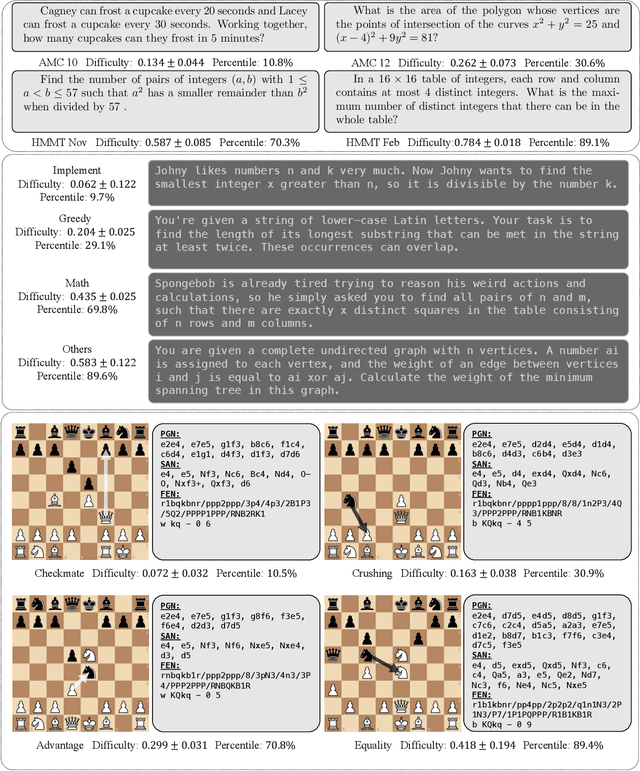
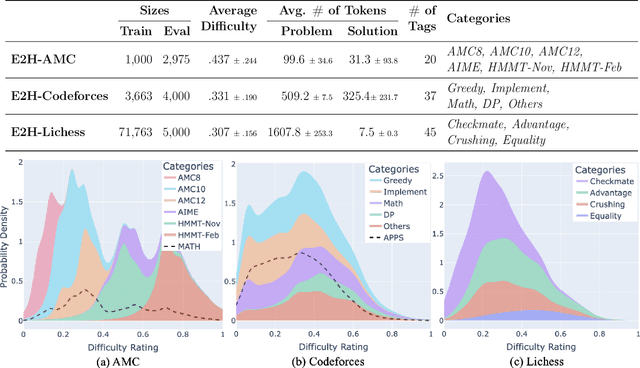
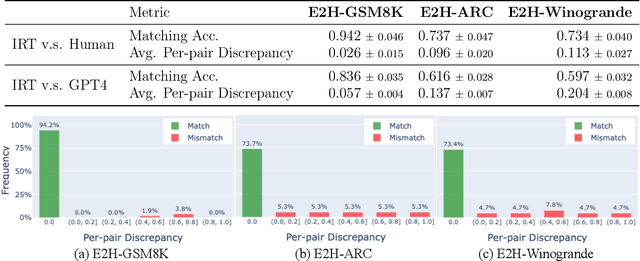
Abstract:While generalization over tasks from easy to hard is crucial to profile language models (LLMs), the datasets with fine-grained difficulty annotations for each problem across a broad range of complexity are still blank. Aiming to address this limitation, we present Easy2Hard-Bench, a consistently formatted collection of 6 benchmark datasets spanning various domains, such as mathematics and programming problems, chess puzzles, and reasoning questions. Each problem within these datasets is annotated with numerical difficulty scores. To systematically estimate problem difficulties, we collect abundant performance data on attempts to each problem by humans in the real world or LLMs on the prominent leaderboard. Leveraging the rich performance data, we apply well-established difficulty ranking systems, such as Item Response Theory (IRT) and Glicko-2 models, to uniformly assign numerical difficulty scores to problems. Moreover, datasets in Easy2Hard-Bench distinguish themselves from previous collections by a higher proportion of challenging problems. Through extensive experiments with six state-of-the-art LLMs, we provide a comprehensive analysis of their performance and generalization capabilities across varying levels of difficulty, with the aim of inspiring future research in LLM generalization. The datasets are available at https://huggingface.co/datasets/furonghuang-lab/Easy2Hard-Bench.
Benchmarking the Robustness of Image Watermarks
Jan 22, 2024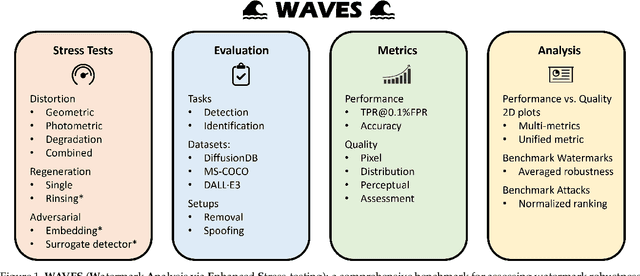
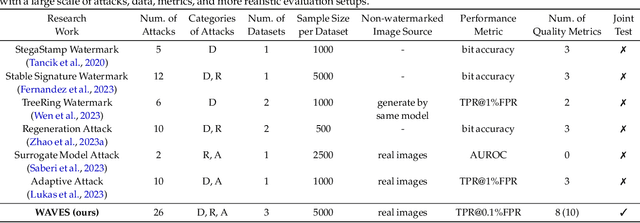

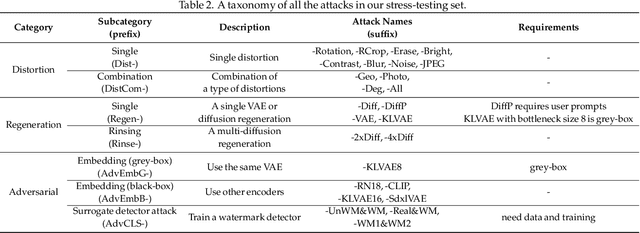
Abstract:This paper investigates the weaknesses of image watermarking techniques. We present WAVES (Watermark Analysis Via Enhanced Stress-testing), a novel benchmark for assessing watermark robustness, overcoming the limitations of current evaluation methods.WAVES integrates detection and identification tasks, and establishes a standardized evaluation protocol comprised of a diverse range of stress tests. The attacks in WAVES range from traditional image distortions to advanced and novel variations of diffusive, and adversarial attacks. Our evaluation examines two pivotal dimensions: the degree of image quality degradation and the efficacy of watermark detection after attacks. We develop a series of Performance vs. Quality 2D plots, varying over several prominent image similarity metrics, which are then aggregated in a heuristically novel manner to paint an overall picture of watermark robustness and attack potency. Our comprehensive evaluation reveals previously undetected vulnerabilities of several modern watermarking algorithms. We envision WAVES as a toolkit for the future development of robust watermarking systems. The project is available at https://wavesbench.github.io/
Robustness to Multi-Modal Environment Uncertainty in MARL using Curriculum Learning
Oct 12, 2023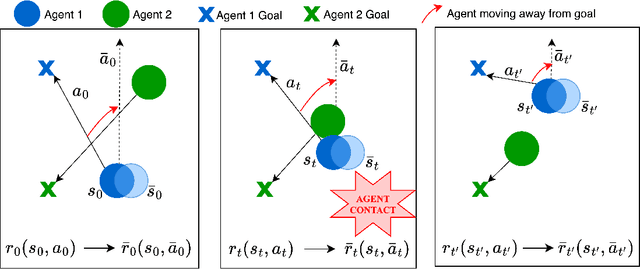



Abstract:Multi-agent reinforcement learning (MARL) plays a pivotal role in tackling real-world challenges. However, the seamless transition of trained policies from simulations to real-world requires it to be robust to various environmental uncertainties. Existing works focus on finding Nash Equilibrium or the optimal policy under uncertainty in one environment variable (i.e. action, state or reward). This is because a multi-agent system itself is highly complex and unstationary. However, in real-world situation uncertainty can occur in multiple environment variables simultaneously. This work is the first to formulate the generalised problem of robustness to multi-modal environment uncertainty in MARL. To this end, we propose a general robust training approach for multi-modal uncertainty based on curriculum learning techniques. We handle two distinct environmental uncertainty simultaneously and present extensive results across both cooperative and competitive MARL environments, demonstrating that our approach achieves state-of-the-art levels of robustness.
Learning When to Trust Which Teacher for Weakly Supervised ASR
Jun 21, 2023



Abstract:Automatic speech recognition (ASR) training can utilize multiple experts as teacher models, each trained on a specific domain or accent. Teacher models may be opaque in nature since their architecture may be not be known or their training cadence is different from that of the student ASR model. Still, the student models are updated incrementally using the pseudo-labels generated independently by the expert teachers. In this paper, we exploit supervision from multiple domain experts in training student ASR models. This training strategy is especially useful in scenarios where few or no human transcriptions are available. To that end, we propose a Smart-Weighter mechanism that selects an appropriate expert based on the input audio, and then trains the student model in an unsupervised setting. We show the efficacy of our approach using LibriSpeech and LibriLight benchmarks and find an improvement of 4 to 25\% over baselines that uniformly weight all the experts, use a single expert model, or combine experts using ROVER.
RTAW: An Attention Inspired Reinforcement Learning Method for Multi-Robot Task Allocation in Warehouse Environments
Sep 13, 2022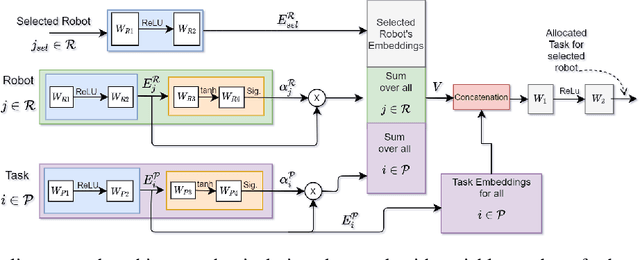
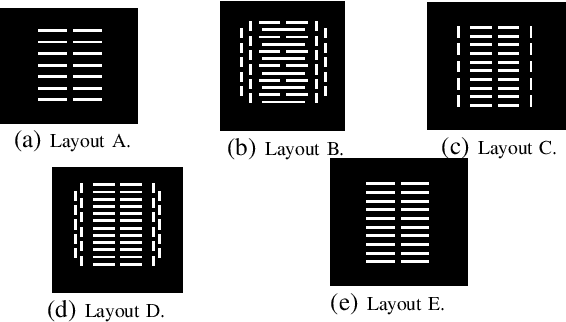
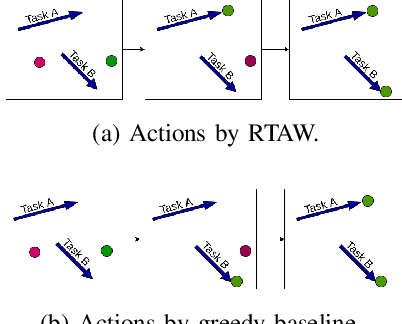
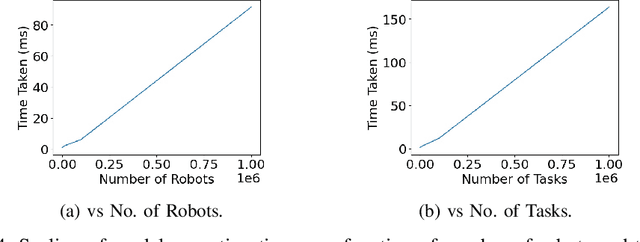
Abstract:We present a novel reinforcement learning based algorithm for multi-robot task allocation problem in warehouse environments. We formulate it as a Markov Decision Process and solve via a novel deep multi-agent reinforcement learning method (called RTAW) with attention inspired policy architecture. Hence, our proposed policy network uses global embeddings that are independent of the number of robots/tasks. We utilize proximal policy optimization algorithm for training and use a carefully designed reward to obtain a converged policy. The converged policy ensures cooperation among different robots to minimize total travel delay (TTD) which ultimately improves the makespan for a sufficiently large task-list. In our extensive experiments, we compare the performance of our RTAW algorithm to state of the art methods such as myopic pickup distance minimization (greedy) and regret based baselines on different navigation schemes. We show an improvement of upto 14% (25-1000 seconds) in TTD on scenarios with hundreds or thousands of tasks for different challenging warehouse layouts and task generation schemes. We also demonstrate the scalability of our approach by showing performance with up to $1000$ robots in simulations.
DC-MRTA: Decentralized Multi-Robot Task Allocation and Navigation in Complex Environments
Sep 07, 2022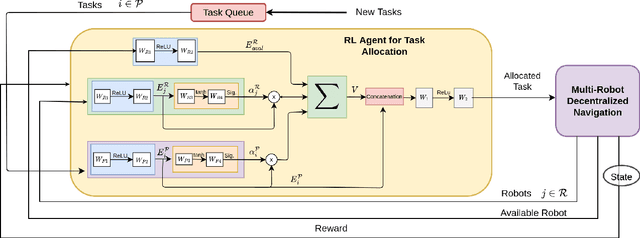
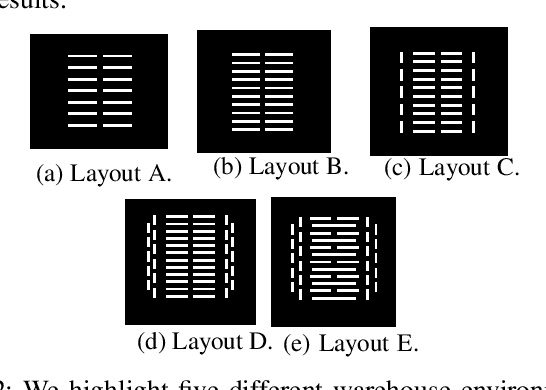
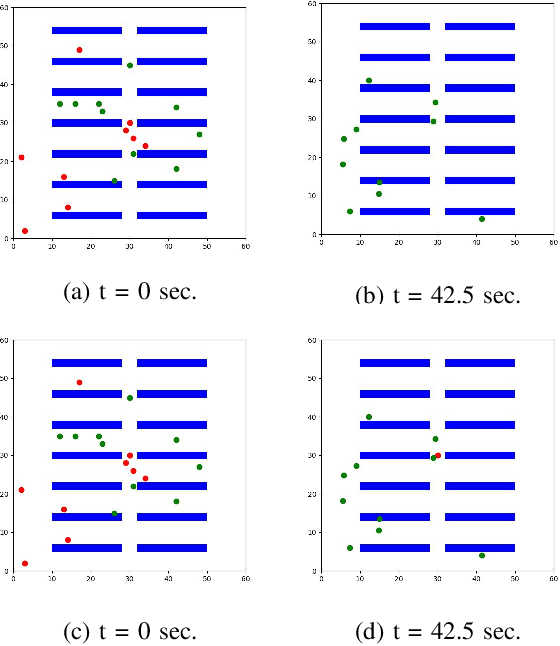
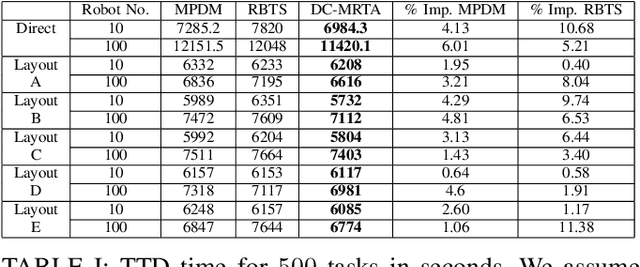
Abstract:We present a novel reinforcement learning (RL) based task allocation and decentralized navigation algorithm for mobile robots in warehouse environments. Our approach is designed for scenarios in which multiple robots are used to perform various pick up and delivery tasks. We consider the problem of joint decentralized task allocation and navigation and present a two level approach to solve it. At the higher level, we solve the task allocation by formulating it in terms of Markov Decision Processes and choosing the appropriate rewards to minimize the Total Travel Delay (TTD). At the lower level, we use a decentralized navigation scheme based on ORCA that enables each robot to perform these tasks in an independent manner, and avoid collisions with other robots and dynamic obstacles. We combine these lower and upper levels by defining rewards for the higher level as the feedback from the lower level navigation algorithm. We perform extensive evaluation in complex warehouse layouts with large number of agents and highlight the benefits over state-of-the-art algorithms based on myopic pickup distance minimization and regret-based task selection. We observe improvement up to 14% in terms of task completion time and up-to 40% improvement in terms of computing collision-free trajectories for the robots.
 Add to Chrome
Add to Chrome Add to Firefox
Add to Firefox Add to Edge
Add to Edge